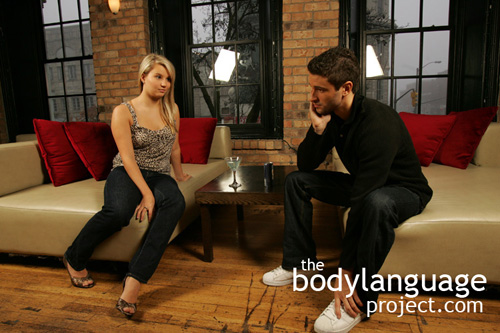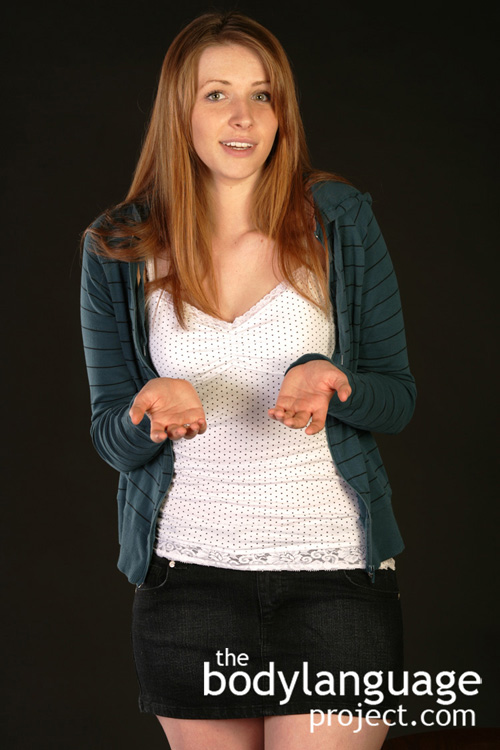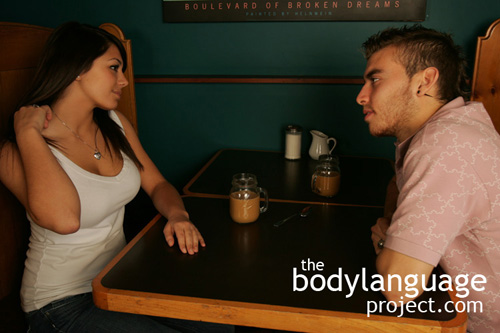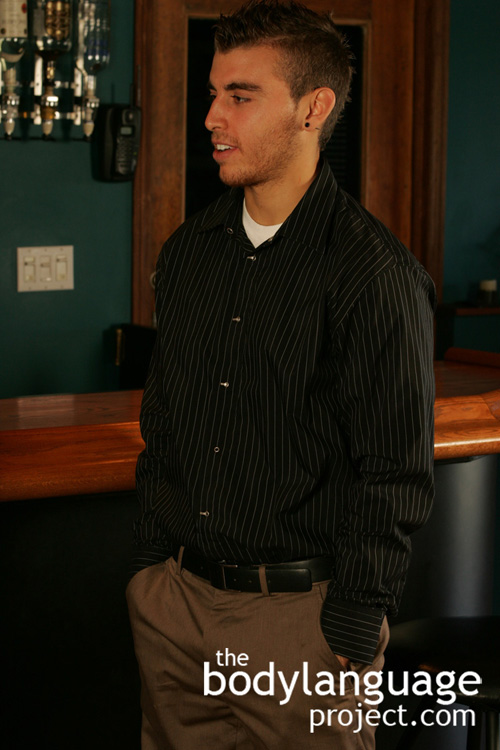The ear rub or pull is as gesture done as a response to greater blood flow to the ears and as a result of an increase in body temperature. Lying ear language can come in the form of a pull downward on the lobe, or as a scratch, or swipe behind the ear. When we get hot, we flush, and the neck and ears are particularly sensitive to flushing. Flushing is the body’s response to an overactive metabolism as it prepares to either fight, or take flight. When this cue is as a result of hearing a lie from someone else, or hearing something that is distasteful, it is done in an attempt to inhibit what a person is hearing by blocking the hears. Only it is not a complete blocking, but rather an abbreviated blocking so instead of covering them completely, the hand merely grazes the ears or pulls on them. Other times liars respond to the stress associated with lying themselves, so the ears are being touched to “block” the hears from hearing their own fib. When someone manages their body in this way, it tells us that they are having an inner battle with their self-image. In other words, this gesture is likely to appear only in those people that are traditionally honest. Pathological liars don’t hold a positive self image, at least not about their honesty and integrity, so feel no remorse from telling a lie and therefore go free of the stress response lying can sometimes produce.
Tag Archive for Honesty
Duping Delight, Eye Contact And Smiling
by Chris Site Author • March 6, 2013 • 0 Comments

Unlike this fella, good liars often appear very charismatic and this trait helps carry them through their lies.
Paul Ekman coined the term “duping delight” to explain possible reasons for an increase in certain cues while lying was taking place. For example, fear and guilt associated with lying should decrease nonverbal cues such as eye contact and smiles, but the research shows us that eye contact usually increases during lying. Ironically, it is the reverse that is commonly thought of by the general public to be true. That is, most people think that eye contact decreases during lying. Two possible explanations exist for an increase in eye contact and smiling. One is that smiling happens more often because the liar is experiencing pleasure with the act of lying which has been extensively proven through research on psychopaths, con-men and pathological liars, the second says that a smile is in fact due to stress and embarrassment which causes a stress smile. An increase in eye contact is also explained in terms of a desire to measure the efficacy of the lie. The liar holds eye contact to watch for signals of disbelief in his counterpart to allow him to calibrate his tactics accordingly. So by this reason, the liar holds eye contact more than truth tellers in order to gauge how well his lie is being pulled over on his victim and to revel in joy as his ploy washes over his victim.
Duping delight means that nearly any signal can be used during a lie to convey honesty, and the greater the pleasure felt by the liar, the more relaxed and honest they will appear. The converse can happen too, the duper can appear more excited and happy throwing a wrench in this signal as universal amongst liars. Signals of duping delight can include higher voice pitch, faster and louder speech, increases in nodding and smiles, and use of more illustrators. Also, the more a lie is being perceived as true, the stronger these signals will be since the excitement of the liar increases in tow. Thus, just because some signals are present, does not necessarily mean that at lie is either present or absent. Although the willful modification of our natural traits often make us appear more or less sincere. For example, a perpetual feigning of friendliness comes across as phony. Incidentally, things like voice pitch, which can be difficult to control amongst all other factors when lying, might go unusually high through anxiousness when the true intent was to appear enthusiastic. It is the difference between a normal interaction and one that is unusually energetic that gives the dupers away.
Wrist And Neck Exposures
by Chris Site Author • March 6, 2013 • 0 Comments

The wrist is a vulnerable part of the body, so when it is flashed, we know that our company trusts us.
What is sexier than an exposed wrist and neck? Well, almost anything I suppose! While these body parts aren’t inherently sexy on their own, they have roots as visceral responses linked to submissiveness. These two areas of our body contain many nerve endings so are very sensitive. A kissing on the neck can run shivers throughout the body and send a woman into fits. Our wrists, to a degree, but our neck in particular, is an extremely vulnerable part of our bodies which we defend rigorously if attacked and the genes we have as a result of eons of evolutionary history supports this. One well placed bite to the throat by cat like predators instantly immobilizes their prey. In a dating context, women show their trust and willingness to submit to men, by revealing their necks and wrists. You can imagine a woman might seductively remove her long hair by bringing it over to one side, or twisting it around a finger then flexing over flashing her neck. She might tilt her head to the side by dropping her head and bring her hand up to carefully stroke and caress the skin on her neck just lightly, so as to draw a man’s eyes on her. In more over cases, woman can even display sexually by coming so close that the neck invites a kiss.
Exposed wrists can come in many forms. They might be revealed in an obvious fashion by placing them on a table with palm up. Added emphasis maybe placed on them by stroking them with a hand or even with the wrist of the opposite arm. Self touching also shows arousal and shows that someone is thinking about being touched, only in this case she is using self touching to satisfy the needs that are currently not being met by the person she fancies. Wrists can be exposed in less obvious ways as well, and these are called wrist flashes. Whenever the palms come up the wrists can flash. Palm flashes are also form of submissiveness and also honesty as we have hit on before. The more flashes, the more interested is delivered. Other incidences of flashes appear as a woman, pulls up a sleeve, plays with her earlobe, or strokes her hair.
Above: While constructing the photographs for the book Body Language Project: Dating, Attraction and Sexual Body Language we ask Julie to show female interest through a neck display. Neck are sensual in dating and attraction because they are full of nerve endings and are vulnerable so when exposed could lead to certain death. While this might not sound sexy in the least, a neck exposure is a signal of the desire to appear subordinate to a more dominant suitor. Neck displays are thus a way of saying that a women is prepared to accept a man. Learn more about sexual body language of women by picking up a copy of the Ebook Body Language Project: Dating, Attraction and Sexual Body Language today!
What Glasses Mean
by Chris Site Author • March 6, 2013 • 0 Comments
As an artifact, glasses can be used to convey nonverbal meaning. Chewing or sucking on the frames of the glasses signifies deep thought. Pens placed in the mouth have the same effect. As we saw with chin stroking, what immediate follows evaluative gestures tells us what sort of decision has been made, be it positive or negative. If arms and legs become crossed, or the body leans back, it means that the person has reached a negative conclusion. The glasses can be shaken from side to side signaling a rejection of an idea which is a tempered way to finger shake – the finger shake by itself indicates a much more powerful message. Boredom can also be signaled with glasses such as folding and unfolding them repeatedly, bending them at the center can indicate agitation, and touching the tips signal tension or stress. Putting the glasses back on means the person wants to see more of the facts, setting them aside can mean that the meeting is over and throwing them aside altogether or dropping them abruptly means a full rejection of the meeting. Quickly anticipating a negative decision can be of assistance to thwart an overt conclusion in effort to leave the door open, even if just a crack. However, obviously, your work is cut out for you to sway someone who is so close to a final decision. You will need to work in overdrive to bring them back from the brink.
Moving the glasses up on the forehead can signal honesty while peering over the glasses is a classic evaluative gesture that signals scrutiny and judgment. The image it invokes in people is that of the discerning librarian or catholic school teacher bearing down on naughty students. The presence of glasses is not paramount to the gesture, but does help make it more salient. With or without glasses it happens by tilting the head downward with the eyes peering onto the subject across the bridge of the nose. With glasses, the gesture includes pulling them forward with the hand and simultaneously peering over them. If the head is cocked to the side it says “Really? You can’t be serious.” The cue cluster also includes arms folded or on the hips, legs crossed, squinted eyes and pursed lips, scowling and or an index finger that wags from side to side (meaning naughty).
Studies show that we also rate wearers of glasses as being more studious, intelligent, sincere and conservative, although having particularly thick glasses negates those positive attributes. We think thick glasses are for those with low social skills who are overly-intelligent (geeks or nerds). While not all of these gestures are perfectly predictive glasses, just like pencils, pieces of paper, folders or books, they are an extension of the hand so carry the same message but in an exaggerated way.
Hands And Palms Language
by Chris Site Author • March 5, 2013 • 0 Comments

The “offerer” in the rogatory posture wants to give you his thoughts and just doesn’t understand your point of view.
The human brain has been shown to place a disproportionate amount of attention on the wrists, palms, fingers and hands compared to the rest of the body. Throughout evolution as we developed the ability to walk upright, our brains became fixated on what our hands were doing because they became more expressive in language through gesticulation, became more skilled such as creating fires, catching prey, collecting berries and building structures and tools to do so. However, our where our hands differ significantly from our feet is their ability to become extremely dangerous. Hands coupled with weapons can inflict deadly blows.
Being open means being honest and not hiding anything. In evolutionary terms, the palm display is an important gesture signifying honesty because it is a way to make evident to others that no threat or weapon is present. Palm and wrist displays have even been noted to be sexual in nature and more frequently flashed by women during courtship likely because it is such a vulnerable part of the body. The wave, as a long distance greeting, probably has roots in showing that we aren’t carrying a spear, sword, or bow and arrow. Having the hands deep in a pocket or behind the back can be a sign of aggression or passive threat, and our evolutionary history tells us that someone who is hiding something is probably not hiding a bouquet of flowers. But if they are, why take the risk! Showing open palms, facing up, or the “palm flash” is essentially what would have happened thousands of years ago when two foreign tribes met. Even today we might guess that a stranger approaching us on the street was up to no good if they hid their hands at their backs or tucked inside a jacket. We’d think they were harboring a gun and planned to rob us.
Having the arms out and extended, palms up, or vertical shows that we are safe and therein lies our most popular greeting, the handshake. The degree to which this openness occurs represents the degree of openness. Having the arms completely to the side or up and open with fingers apart is as open as one can get and it signal as much. We rarely see this form of openness, rather, openness is of degree, so we therefore must look for more subtle and acceptable cues.
Open gestures are accompanied by phrases such as “Trust me.”, “I wouldn’t lie to you.” and “What, you don’t believe me?” We also gesture with palms facing upward when we are offering something. However, the offering, in this context, isn’t a tangible item, rather, it’s an idea. It could be a cell phone plan coming from a salesman in the mall, or a reorganizing of the company, a downsizing, or new way to deal with customers or any number of things requiring deal making or selling.
When the arms are completely outstretched with palms up we call it the “rogatory” posture, or prayer-like. It is as if we are offering dialogue to another and sincerely want to be believed, trusted and accepted. This posture is not dominant or even confident however, because it lacks conviction. So while palm flashes show honesty and trustworthiness because they show no threat, they lack sustenance and power in terms of conviction. Palm down displays though, by placing hands face down on a table or standing head on and leaning with the fingertips spread to anchor the body shows emphatically that a position is held confidently. While conversing on a topic, we should therefore expect both palms up and palms down as opinions are either offered with reservation or presented with conviction. Depending on your position on the matter you may wish to employ either submission or dominance to your advantage. For example, on issues you wish to concede or are unsure of, of which making the other party aware of this fact is acceptable, use palm up, but when you wish not to concede or wish not to be uncovered as unsure, keep palms face down. The rule of thumb is that palms down “tell”, while palms up, “offer.” When someone wishes to display honesty, such as declaring “You have to believe me, I didn’t do it” they should use palm down displays otherwise they may not be telling the truth and expect not to be believed.
So why do we find it comfortable to put our hands in our pockets? Our clothing, especially that of men’s, is specifically designed with this in mind. The fashion of women rarely permits the luxury of the same deep pockets, but this isn’t to say they wouldn’t take advantage of them if they could. Curiousity says that we must reason why this is so. What is it about this hand placement that makes us more at ease? Are men more reserved to the point of requiring their garments to accommodate their needs or is it just superfluous? There’s no doubt that form meets function in this case, and putting our hands in our pockets makes us feel more comfortable and gives us a way to occupy our hands, but what does the body language convey to others?
When children lie they can be found to place their hands behind their back concealing them. This is a dishonest gesture. As we grow into adulthood, this gesture becomes more condensed and our hands find a new place in pockets. Seeming outright dishonest for having your hands buried in pockets is a bit extreme, but context specific could be a ‘tell.’ Regardless though, hidden hands convey a lack of confidence especially when the hands would be best served to gesture appropriately in conversation. The hands are a very effective way to colour our dialogue and make us appear more honest and intelligent. When delivering important information showing the flesh of the palms, the “palm flash” can be critical to portray honesty. At a subconscious level, as the palms are made more visible, the more honest others will find the speaker. Give it a try!




